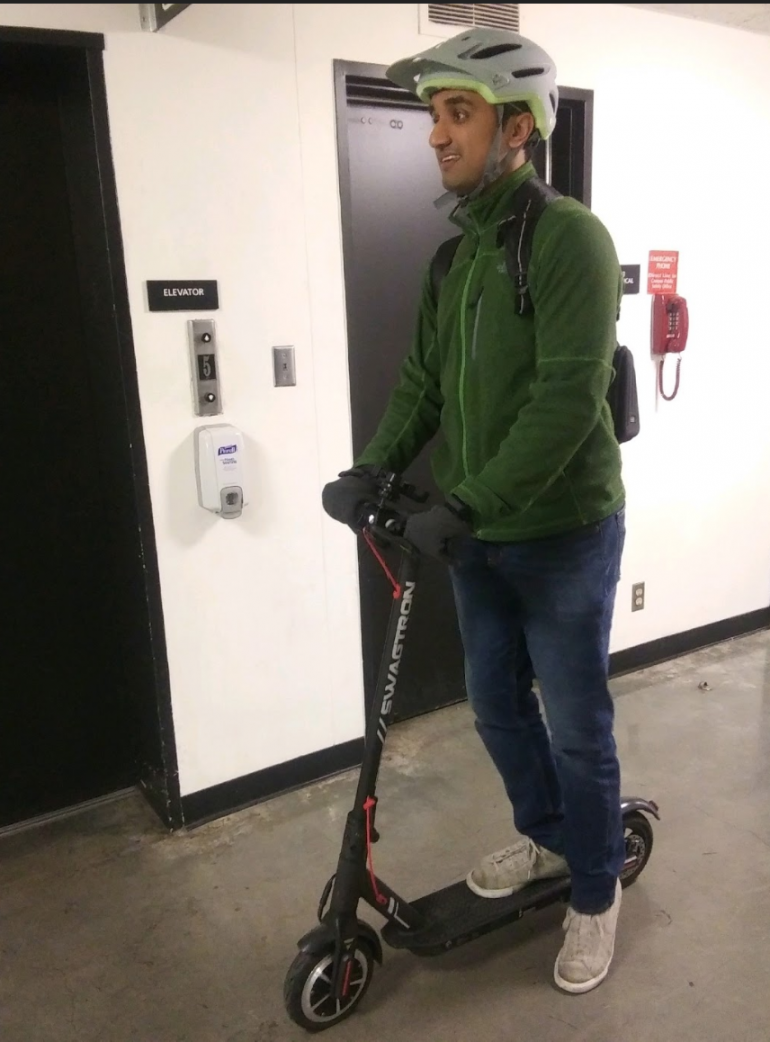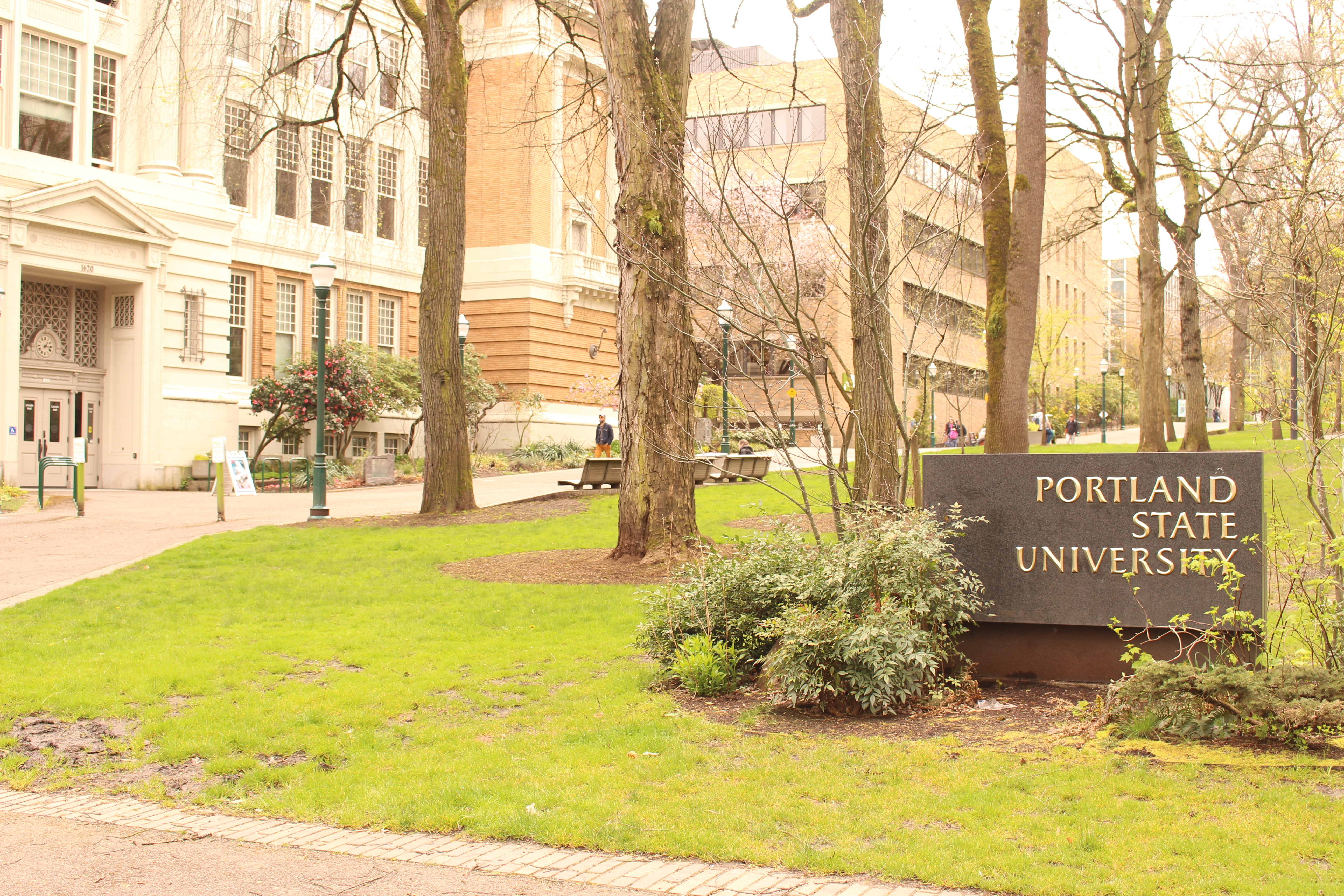Oregon law currently requires bicyclists under 16 years old and e-scooter riders of all ages to wear a helmet. In 2016, Portland Bureau of Transportation (PBOT) kicked off a bike-share program called BIKETOWN, and various e-scooter share programs are slated to return to Portland this spring after a popular pilot period. These micro-transportation programs have been successful, but riders rarely wear helmets. PBOT gave away 500 free helmets during an e-scooter safety event halfway through the pilot program; the three e-scooter companies, Lime, Bird, and Skip, also hosted helmet giveaways during the trial. But, PBOT reported 176 scooter-related emergency room visits during the e-scooter pilot period and estimated that 90 percent of all riders did not wear a helmet.
Should there be a helmet share program too? Sandeep Chandrasekhar, a graduate student at University of Oregon, thinks so. Chandrasekhar was born in New Delhi, India and grew up in the Bay Area. He has a passion for environmentally friendly transportation options and understands the necessity of safety in this rapidly expanding field. He is interested in micro-mobility transportation and human body protection, and is currently prototyping an environmentally friendly helmet as well as a helmet-share program to accompany micro-transportation options. Chandrasekhar is now meeting with investors in hopes of finalizing a program to pitch to the City of Portland to protect noggins.
Jacob Brauer: Where do you see your helmet startup incorporating into the Metro transit system?
Sandeep Chandrasekhar: It’s good because there is no viable program for ride-sharing helmets currently. This need is going to be met by us preventing the need for ownership, which will encourage more people to use public transit options. Micro-mobility is single-person use vehicles, and since these take up less space, it will help traffic congestion in the city because it’s easy to get from one place to the next using a micro-mobility option.
Ride-sharing and micro-mobility allows for people to get from doorstep to doorstep as quickly as possible. This is a good complement to public transit because public transit rarely gets the user from doorstep to doorstep; and this will help do so because it encourages more people to use public transportation options in densely populated areas by increasing accessibility and safety.
We want to encourage the option for micro-mobility in densely populated regions.
Currently helmets are absolutely on outside expanded polystyrene foam (EPS) on inner liner, which is a cradle-to-grave option [the lifecycle of a product’s material components end when the product is no longer used, i.e. throwing your phone in the trash instead of recycling the components]. Our helmet redesign is an environmentally friendly Cradle to Cradle option [design that attempts to mimic nature by reusing materials that are waste]. This is a bonus for a more Cradle to Cradle option that prevents the need for ownership in densely populated urban settings.
JB: Do you plan on working with just Portland or with other cities as well?
SC: Hopefully other cities, any big densely populated urban areas work. We were thinking about San Francisco, New York City, Boston, Seattle, and Philadelphia.
JB: Do you see the effort that you’re putting into your startup influencing the following of the legality of mandatory helmet wearing on e-scooters?
SC: Yes, but e-scooters are very new. The whole thing is much more about micro-mobility as a whole, not just about e-scooters. E-scooters’ success is way too early to tell is the thing. Micro-mobility in one form or another is here to stay.
JB: The question that no one wants to talk about is lice—what are you going to do about this issue?
SC: A phenomenal question. This is the reason the current helmet technology is not a communal use option currently, that ends up forcing individual ownership. We need to look into the processes to ensure cleanliness of materials before and after use [and] environmental concerns with disposal and recycle of cleaning products and materials. This is a big time issue, and we take this very seriously. We care about user and environmental safety and this is a big time potential engineerable breakthrough in helmet technology that we are going to solve.
JB: There’s a lot of talk in Portland about the legal mandate for helmets. Do you think your technology could influence any legislation?
SC: Yes, we have to solve it right now, we have to look at the customer solution right now. Helmet use was the most prevalent complaint from the [PBOT] about bicycle sharing and e-scooter sharing. There has to be a viable solution to incentivize helmet wearing on micro-mobility vehicles.
JB: The fine for operating a motorized scooter in Portland without protective headgear is $25. Has this ever happened to anyone you know?
SC: No.
JB: What type of helmet sharing program is this going to be used for? Is it the same as the scooters where you can just leave the helmets anywhere?
SC: That’s the goal that’s going to depend on the product layout and how that ends up happening. To get from point A to point B as possible, anything damaging the customer experience is not going to be an option. This is to make micro-transportation options easier not harder, so this is all going to depend on how the the product layout is performed.
JB: Are they going to be customizable?
SC: I don’t know yet!
JB: Would you customize yours?
SC: I can’t give you a fair answer on that at this time.
JB: Thank you very much for your time.
SC: You too!





